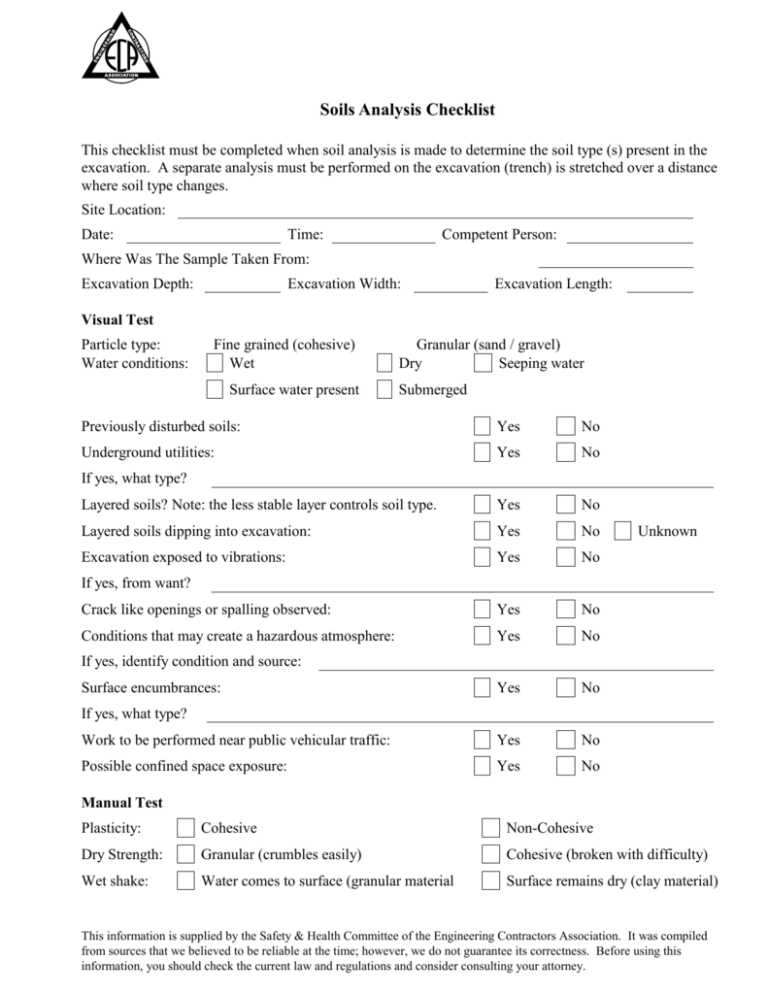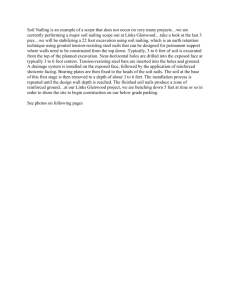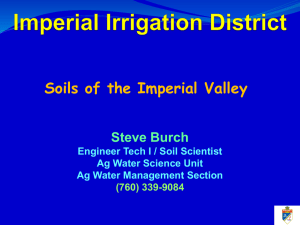Soils Analysis Checklist
advertisement

Soils Analysis Checklist This checklist must be completed when soil analysis is made to determine the soil type (s) present in the excavation. A separate analysis must be performed on the excavation (trench) is stretched over a distance where soil type changes. Site Location: Date: Time: Competent Person: Where Was The Sample Taken From: Excavation Depth: Excavation Width: Excavation Length: Visual Test Particle type: Water conditions: Fine grained (cohesive) Wet Surface water present Granular (sand / gravel) Dry Seeping water Submerged Previously disturbed soils: Yes No Underground utilities: Yes No Layered soils? Note: the less stable layer controls soil type. Yes No Layered soils dipping into excavation: Yes No Excavation exposed to vibrations: Yes No Crack like openings or spalling observed: Yes No Conditions that may create a hazardous atmosphere: Yes No Yes No Work to be performed near public vehicular traffic: Yes No Possible confined space exposure: Yes No If yes, what type? Unknown If yes, from want? If yes, identify condition and source: Surface encumbrances: If yes, what type? Manual Test Plasticity: Cohesive Non-Cohesive Dry Strength: Granular (crumbles easily) Cohesive (broken with difficulty) Wet shake: Water comes to surface (granular material Surface remains dry (clay material) This information is supplied by the Safety & Health Committee of the Engineering Contractors Association. It was compiled from sources that we believed to be reliable at the time; however, we do not guarantee its correctness. Before using this information, you should check the current law and regulations and consider consulting your attorney. Note: The following unconfined compressive strength tests should be performed on undisturbed soils. Thumb Test used to estimate unconfined compressive strength of cohesive soil. Test performed: Yes No Type A - soil indented by thumb with very great effort. Type B - soil in dented by thumb with some effort. Type C - soil easily penetrated several inches by thumb with little or no effort. If soil is submerged, seeking water, subjected to surface water, runoff, exposed to wedding. Penatrometer or Shearvane used to estimate on confined compresses strength of the cohesive soils: Test performed: Yes No Device Used: Type A soil: Cohesive soils with an unconfined, compressive strength of 1.5 ton per square foot (tsf) or greater. Examples of cohesive soils are: clay, silty clay, sandy clay, clay loam and, in some cases, silty clay loam and sandy clay loam. Cemented soils such as caliche and hardpan are also considered Type A. However, no soil is Type A if: (1) The soil is fissured; or (2) The soil is subject to vibration from heavy traffic, pile driving, or similar effects; or (3) The soil has been previously disturbed; or (4) The soil is part of a sloped, layered system where the layers dip into the excavation on a slope of four horizontal to one vertical (4H:1V) or greater; or (5) The material is subject to other factors that would require it to be classified as a less stable material. Type B soil: (1) Cohesive soil with an unconfined compressive strength greater than 0.5 tsf but less than 1.5 tsf; or (2) Granular cohesionless soils including: angular gravel (similar to crushed rock), silt, silt loam, sandy loam and, in some cases, silty clay loam and sandy clay loam. (3) Previously disturbed soils except those which would otherwise be classed as Type C soil. (4) Soil that meets the unconfined compressive strength or cementation requirements for Type A, but is fissured or subject to vibration; or (5) Dry rock that is not stable; or (6) Material that is part of a sloped, layered system where the layers dip into the excavation on a slope less steep than four horizontal to one vertical (4H:1V), but only if the material would otherwise be classified as Type B. Type C soil: (1) Cohesive soil with an unconfined compressive strength of 0.5 tsf or less; or (2) Granular soils including gravel, sand, and loamy sand; or (3) Submerged soil or soil from which water is freely seeping; or (4) Submerged rock that is not stable, or (5) Material in a sloped, layered system where the layers dip into the excavation or a slope of four horizontal to one vertical (4H:1V) or steeper. Soil Classification Stable Rock Type A Type B Type C Selection of Protective System Protective System: Sloping Specify angle __________________ Timber Shoring Aluminum hydraulic shoring Trench shield maximum depth in this soil This information is supplied by the Safety & Health Committee of the Engineering Contractors Association. It was compiled from sources that we believed to be reliable at the time; however, we do not guarantee its correctness. Before using this information, you should check the current law and regulations and consider consulting your attorney.







